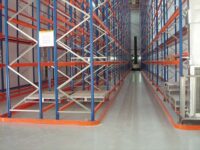 Technological advances in flooring mean surfaces underfoot in warehouse environments are much more than just a walk-over.
Technological advances in flooring mean surfaces underfoot in warehouse environments are much more than just a walk-over.
Here Alan Dean, sales director of flooring manufacturer Flowcrete, gives an insight into the issues relating to flooring for the warehouse industry.
“In the main, a floor is the part of a building subjected to the most stress and strain – taking far more weight and movement than other parts of a construction.
“Therefore, it is important a building has a robust platform underfoot to cope with the day-to-day demands placed on it.
“That means a floor finish that can withstand factors such as wheeled traffic, from fork lift trucks, trolleys and other machinery in use, resistant to any chemicals that might come into contact with the surface and any impacts that might be encountered too. Extremes of temperature also need to be considered too.
“As well as these considerations, in a warehouse environment further features need to be considered too.
“Due to stacking systems, warehouse floors generally need to be completely level, to pinpoint accuracy.
“Furthermore, a completely level surface is also required where sensitive AVG systems are in use.
“Professional installation methods mean level floors can be achieved, working to SR1 standard, but it is important to specify this from the start.
“Safety is a priority in warehouses and here a good floor can assist too. Slip-resistant surfaces can help to reduce the chance of injuries and well thought out designs can be used to demarcate different zones, crossing areas and walkways.
“Another factor specific to warehouses is static, particularly in areas where electrical goods are in place.
“Flooring systems with anti-static capabilities can be installed, such as Flowcrete’s Peran ESD, which deliver a safer working environment, yet still have the qualities needed for warehouse environments, such as durability and a level surface.
“To get the right floor that is fit-for-purpose, the important things to consider are design, product and installation – which includes ground preparation. All these factors rely on each other for a successful end result.
“By paying close attention to design, the right product is more likely to be specified for a particular environment. For example, in oily areas, a high anti-slip grade is needed, while flexible flooring might be needed in areas where heavy machinery operates to cope with movement.
“Requirements such as these all need to be identified at the outset and built into the project at the design stage to ensure the right floor for the job. Attention to the design process will identify the right product for a particular environment.
“Once the actual floor plan is completed and the correct products specified, the preparation work and installation begins.
“Preparation work is crucial. Depending on the type of property being considered – whether it is a new build or refurbishment project – the floor slab needs to be carefully primed to receive the floor finish.
“Although this involves treating an out-of-sight area once the new finish is installed, if neglected, the flooring system could be blighted by osmosis, become uneven or even not bind in-situ to the ground.
“Done properly, a new floor will provide a safer, brighter, hard-wearing environment – but it is important to pay attention to all these factors to achieve success.”
To find out more about flooring in warehousing, FeRFA, the Resin Flooring Association has a website www.ferfa.org.uk which offers a comprehensive guide to specification and application.
For more information visit www.flowcrete.co.uk




Comments are closed.